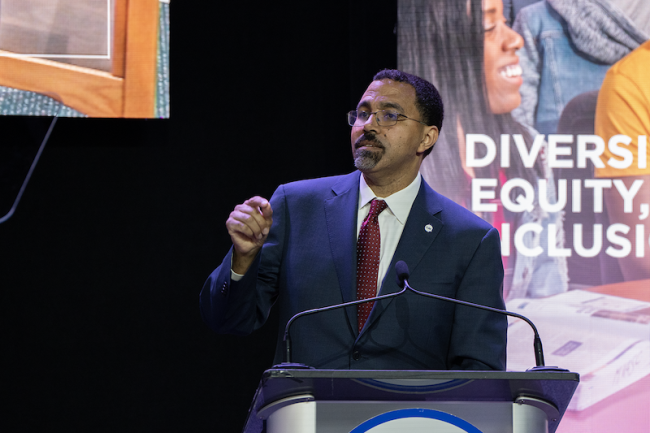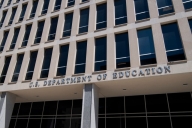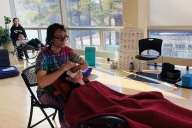You have /5 articles left.
Sign up for a free account or log in.

John B. King has made housing and food insecurity two of his key priorities in his relatively new role as chancellor of the State University of New York.
SUNY system
Navigating college can be especially challenging for students experiencing homelessness.
“At a very basic level, housing insecurity and homelessness are a real risk to student success,” said Bryce McKibben, senior director of policy and advocacy at the Hope Center for College, Community and Justice, which is dedicated to equity in higher education. “If students are worried about where they’re going to stay, if they have a safe place to stay, they’re not going to focus on their academics and being their whole selves.”
That’s why many institutions have begun increasing supports for homeless students, who make up 14 percent of the college population, according to Hope Center data from 2021. The figure includes any student who indicated in the survey that in the previous 12 months they had lived somewhere other than a permanent residence, including at a hotel, in a car, at a shelter or on a friend’s couch.
This fall, the State University of New York will become the latest U.S. university system to introduce homeless liaisons, an increasingly popular strategy on campuses seeking to address homeless students’ needs. Each of the SUNY system’s 64 campuses will designate its own liaison, making it the largest coordinated effort in the country.
The role of homeless liaison—usually undertaken by an existing campus employee, such as a member of the financial aid or student affairs staff—is to serve as a touch point for students struggling with housing insecurity or homelessness, connect them with available resources, and follow them to ensure they are on track with their academics.
SUNY chancellor John B. King Jr. announced the initiative at his inaugural State of the University address in late May. (A former U.S. secretary of education under President Obama, King took on the role of chancellor in January.) In his speech, he said that each university’s president had been tasked with appointing a liaison by next fall. Guidance from the chancellor will go out this week about how to select the best person for the job.
“Coming to SUNY, I knew this was an area I wanted to focus on,” he told Inside Higher Ed in an interview. “But one of the first things I did, [after] becoming chancellor in January, was to visit all 64 of our campuses, and this issue, not surprisingly, of student homelessness and student housing insecurity came up as I talked with students across our campuses.”
The chancellor also announced in his State of the University address that SUNY would take steps to decrease food insecurity on campus by helping students access SNAP benefits—federal food assistance for low-income people—and providing $1 million in recurring support for on-campus food pantries.
Origins in K-12 Systems
Homeless liaisons have existed to support students facing housing insecurity since the McKinney-Vento Homeless Assistance Act of 1997, which required each K-12 school district in the country to designate such a liaison. In recent years, the model has been adopted by institutions of higher education in seven states, beginning with Louisiana in 2016. All seven passed legislation mandating the appointment of a homeless liaison at either every university or every public university. The liaisons are often responsible for working with former foster youth as well.
McKibben said that the model is now considered best practice for supporting homeless students.
“It grew out of the K-12 environment, and because it was a successful model in K-12, it was able to spread to higher education,” he said. “You had someone who was actually in charge of keeping an eye on issues and barriers individuals facing homelessness had.”
SUNY will partner with SchoolHouse Connection, a youth homelessness nonprofit that has worked on state legislation concerning homeless liaisons and recently launched a Learning Network for such liaisons in higher education to connect with one another. (The organization is also advocating for similar federal legislation, which they hope will be introduced in the near future.)
The organization will help each SUNY campus figure out how best to support their housing-insecure students, whether that means partnering with local organizations, taking advantage of on-campus services or finding resources elsewhere.
SchoolHouse Connection will also help SUNY officials learn best practices for identifying homeless students—something that Jillian Sitjar, director of higher education partnerships at SchoolHouse Connection, said can be deceptively difficult.
“There isn’t great data on how to identify and find students; there is FAFSA, but sometimes that isn’t the most accurate” because it primarily captures information about unaccompanied homeless students as opposed to students whose families are homeless, she said.
For that reason, part of the role of the homeless liaison is to help educate and train fellow staff members on campus in how to identify students who might be struggling with homelessness and connect them to the liaison, she said.
SchoolHouse Connection will also help SUNY avoid mistakes previous institutions have made in designating a liaison. Sitjar said she has heard horror stories, for example, of staff members receiving notice out of the blue that they would begin serving as a homeless liaison without any training or clarification about what that would entail.
Research by SchoolHouse Connection also shows that universities often make it unnecessarily difficult for homeless students to connect with their liaison by failing to put their contact information online.
“If you’re not marketing that, if you’re not advertising that, it doesn’t do anything,” she said. “If we have this liaison role, but we’re not telling our students, how are we expecting our students to get in contact? … It’s a really easy fix.”
Funding for Basic Needs
The funding to support this and other efforts to address basic needs insecurity at SUNY will come from a new $75 million fund, called the SUNY Transformation Fund, which is included in the governor’s 2024 budget. The system also received $10 million specifically for student mental health services and another $10 million for disabled student services as part of a $163 million operating budget increase.
Funds will be distributed to each campus and can be used for a number of purposes including “delivering essential student supports for targeted under-served populations.”
“Quality public higher education is an engine of social mobility that has the power to change lives, like it did for my own family,” Governor Kathy Hochul said in a press release. “My administration is committed to creating the best public education institution in the country so that more students can build a bright future for themselves and be equipped to take on the jobs of the future.”
While the money is not being specifically allocated for the homeless liaisons, King said he hopes it will help the system’s campuses better support those positions and provide the resources they need to help students.
“The folks who are working on student supports are going to see more resources for their team … so those teams are in a better position, maybe, than some of the McKinney-Vento coordinators have been in really fiscally challenged districts,” he said. “But that said, part of what we’re hoping that the SchoolHouse Connections network will help people do is figure out [is] how do they best leverage the available resources on campus to support students?”




